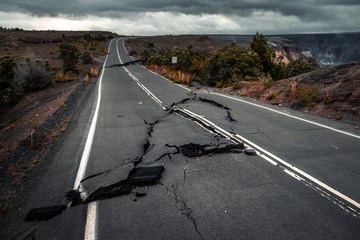This article was originally published by Sara Tipton at Tess Pennington’s Ready Nutrition.

Earthquakes can happen when we least expect them, and unless you live near a fault line you probably haven’t thought too much about them. But it’s important to know what to expect when an earthquake strikes, what to do during the quake, and actions to take immediately afterward.
An earthquake is caused by a sudden slip on a fault – the point where the tectonic plates meet. The tectonic plates are always slowly moving, but they get stuck at their edges due to friction and when the stress on the edge overcomes the friction, there is an earthquake that releases energy in waves that travel through the earth’s crust and cause the shaking and destruction that we experience on the surface of the Earth.
WHAT TO EXPECT
During an earthquake, your experience will very much depend on the severity of the quake. In a mild or moderately mild earthquake, expect ceiling lights to move, shake, and/or sway and some minor rattling of objects may occur in your home. If it’s slightly stronger than a mild quake, pictures could come off the walls or things could fall off shelves and break. You may feel a slight quiver under your feet if you are outside. If you are close to its source, you may hear a loud bang followed by shaking. These milder quakes usually only last a few seconds at the most. There will be little to no damage and no actions need to be taken other than to get away from anything that can possibly fall on your head.
If you happen to experience a large earthquake, things will be dramatically different. A large quake can last for several minutes. The ground or floor will move, perhaps violently depending on the magnitude and your proximity to the epicenter (the exact point where the earthquake occurs.) If you are far away from the source, you might see swaying buildings or hear a roaring sound. Whether far away or close to the source, you will likely feel shaking followed by a rolling motion, much like being at sea. You may also feel dizzy sensation and be unable to walk during an extreme earthquake. The shaking will be intense! If you live in a high rise or a multi-story building, you could experience more sway and less shaking than in a smaller, single-story building, or your home. The lower floors of multi-story building shake rapidly, much like residential homes. Furnishings and unsecured objects could fall over or slide across the floor with some force. Unsecured light fixtures and ceiling panels may fall and it is possible for windows may break. Fire alarms and sprinkler systems may be activated and the power grid could go down, meaning the electricity would go off and you would have no power.
WHAT TO DO
If you find yourself indoors during a severe earthquake, you’ll want to take action quickly to prevent injury or death. Do NOT go outside! Find a sturdy piece of furniture to get under and cover your head and face with your arms and hands. If you need to, hold onto the object covering you so you remain under its protection. Stay away from windows and shelves. If you don’t have any furniture, go as far away from the outer walls as you can, crouch down against an INTERIOR wall. Face away from the windows if you must be near them!
If you are outside when an earthquake occurs, move away from buildings. Don’t go inside! If you are around crowds of people, try to get to an area where you will be safe from being trampled.
If you’re driving when the earthquake strikes, pull over to a safe place where you are not blocking the road an keep the roads clear for rescue and emergency vehicles. Stay inside the vehicle! Avoid bridges, overpasses, underpasses, buildings or anything else that could possibly collapse. Turn your car radio on and listen for instructions from emergency officials. Do not attempt to get out of your car if downed power lines are across it. Wait to be rescued. You can put a HELP sign in the window of your car if you need assistance.
WHAT TO DO AFTER AND EARTHQUAKE
The first thing you should do is remain calm, and if you are uninjured, help others who may be stuck or hurt. Turn on a radio so you can be made aware of any information about the quake that just took place. Put on sturdy shoes and protective clothing (if you can get to them) to help prevent injury from debris, especially broken glass. Check your home for structural damage and other hazards. If you suspect your home is unsafe, do not re-enter. Grab your emergency bag if you have to head out.
Preparing for an earthquake is going to be similar to preparing for other types of natural disasters. If you would like a comprehensive breakdown and a step by step guide, consider reading The Prepper’s Blueprint by Tess Pennington. The book offers tips and guidance on preparations for every kind of disaster, including earthquakes.
You should have an emergency bag already put together and in a place that’s easily accessible. This can also be your bug out bag, so if you have one of those, you’re likely already prepared. Some have car emergency kits and that will have several items you’ll need in it too. If you live in an area where earthquakes are common, you’ve likely already got everything in an emergency bad that you would need in the aftermath of a devastating earthquake.
*TIP: Put your emergency bag in a place that makes it easy to get to. After a large earthquake (one that destroys buildings) you may not be able to safely obtain your bag. Keep it in a garage or hidden outside. It won’t do you any good in a closet of a house that is falling down.
Inside your bag, you should have things that will help sustain you for a few nights or days until more permanent measures can be taken. Consider having a tent and some food and water in the bag. A flashlight, some matches or a lighter, and a life straw are all excellent additions too. You may want a knife and a few personal hygiene items as well as a first aid kit. How you pack your bag and any additional items will be at your discretion.
Come up with a plan and make sure the whole family knows what to do and where the emergency bag is located. Planning ahead is the best way to mitigate injury or worse when the absolute worst natural disaster occurs.












0 Comments